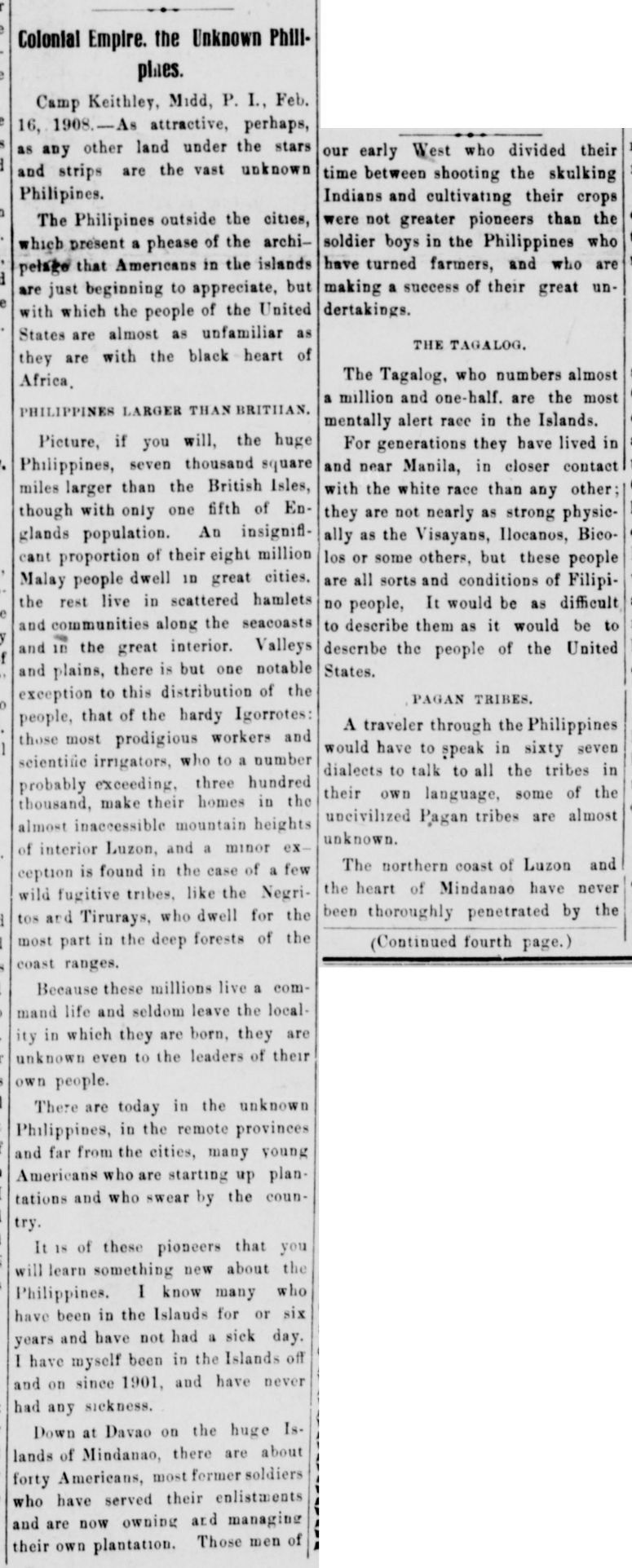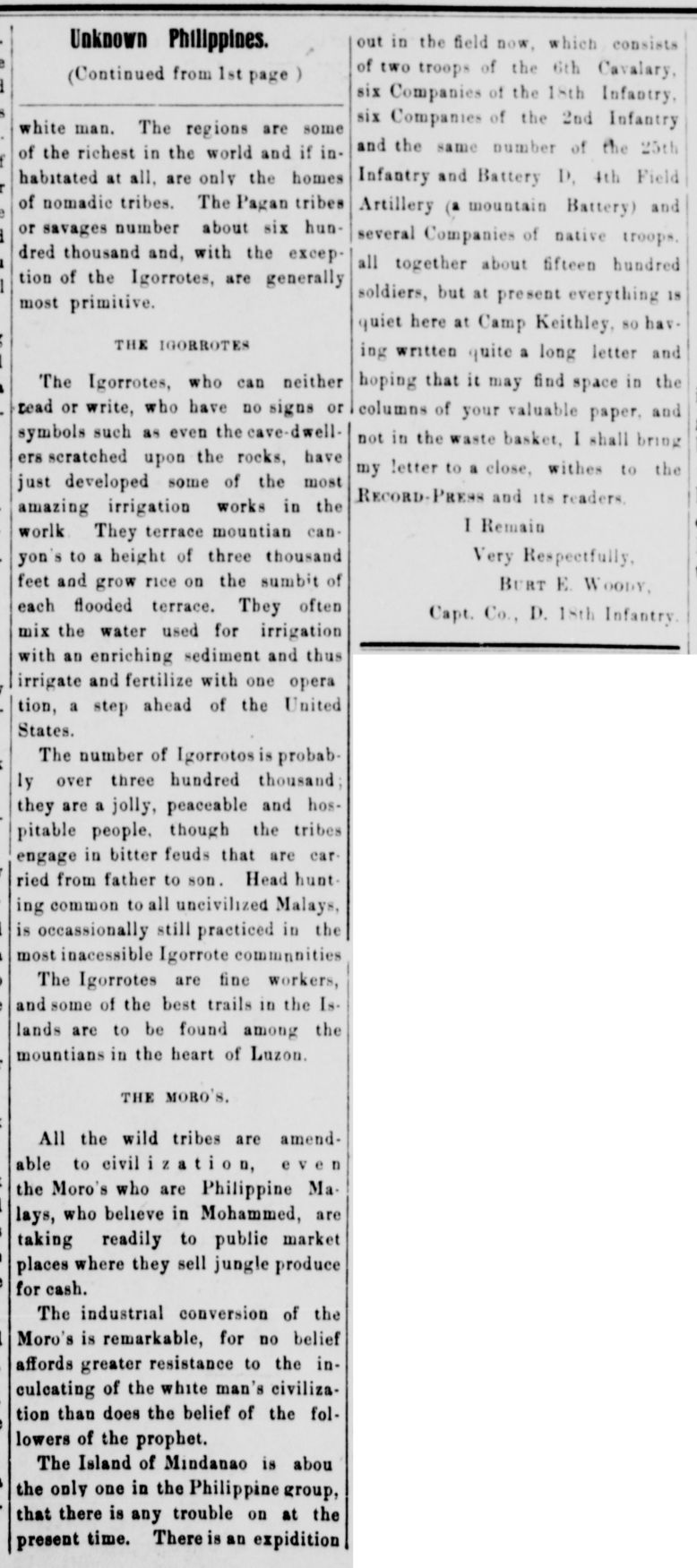April 9, 1908
Colonial Empire, the Unknown Philipines [sic]
Camp Keithley, Midd, P. I., Feb. 16, 1908.--As attractive, perhaps, as any other land under the stars and stripes are the vast unknown Philipines [sic].
The Philipines [sic] outside the cities, which present a phease [sic] of the archipelago that Americans in the islands are just beginning to appreciate, but with which the people of the United States are almost as unfamiliar as they are with the black heart of Africa.
PHILIPPINES LARGER THAN BRITIIAN [sic].
Picture, if you will, the huge Philippines, seven thousand square miles larger than the British Isles, though with only one fifth of Englands population. An insignificant proportion of their eight million Malay people dwell in great cities, the rest live in scattered hamlets and communities along the seacoasts and in the great interior. Valleys and plains, there is but one notable exception to this distribution of the people, that of the hardy Igorrotes; those most prodigious workers and scientific irrigators, who to a number probably exceeding, three hundred thousand, make their homes in the almost inaccessible mountain heights of interior Luzon, and a minor exception is found in the case of a few wild fugitive tribes, like the Negritos and Tirurays, who dwell for the most part in the deep forests of the coast ranges.
Because these millions live a command life and seldom leave the locality in which they are born, they are unknown even to the leaders of their own people.
There are today in the unknown Philippines, in the remote provinces and far from the cities, many young Americans who are starting up plantations and who swear by the country.
It is one of these pioneers that you will learn something new about the Philippines. I know many who have been in the Islands for [sic] or six years and have not had a sick day. I have myself been in the Islands off and on since 1901, and have never had any sickness.
Down at Davao on the huge Islands of Mindanao, there are about forty Americans, most former soldiers who have served their enlistments and are now owning and managing their own plantation. Those men of our early West who divided their time between shooting the skulking Indians and cultivating their crops were not greater pioneers than the soldier boys in the Philippines who have turned farmers, and who are making a success of their great undertakings.
THE TAGALOG.
The Tagalog, who numbers almost a million and one-half, are the most mentally alert race in the Islands.
For generations they have lived in and near Manila, in closer contact with the white race than any other; they are not nearly as strong physically as the Visayans, Ilocanos, Bicolos [Bicolanos] or some others, but these people are all sorts and conditions of Filipino people. It would be as difficult to describe them as it would be to describe the people of the United States.
PAGAN TRIBES.
A traveler through the Philippines would have to speak in sixty seven dialects to talk to all the tribes in their own language, some of the uncivilized Pagan tribes are almost unknown.
The northern coast of Luzon and the heart of Mindanao have never been thoroughly penetrated by the white man. The regions are some of the richest in the world and if inhabitated [sic] at all, are only the homes of nomadic tribes. The Pagan tribes or savages number about six hundred thousand and, with the exception of the Igorrotes, are generally most primitive.
THE IGORROTES
The Igorrotes, who can neither read or write, who have no signs or symbols such as even the cave-dwellers scratched upon the rocks, have just developed some of the most amazing irrigation works in the worlk [sic]. They terrace mountian [sic] canyon's to a height of three thousand feet and grow rice on the sumbit [sic] of each flooded terrace. They often mix the water used for irrigation with an enriching sediment and thus irrigate and fertilize with one operation, a step ahead of the United States.
The number of Igorrotos [sic] is probably over three hundred thousand; they are a jolly, peaceable and hospitable people, though the tribes engage in bitter feuds that are carried from father to son. Head hunting common to all uncivilized Malays, is occassionally [sic] still practiced in the most inacessible [sic] Igorrote communities.
The Igorrotes are fine workers, and some of the best trails in the Islands are to be found among the mountians [sic] in the heart of Luzon.
THE MORO'S
All the wild tribes are amendable to civilization, even the Moro's who are Philippine Malays, who believe in Mohammed, are taking readily to public market places where they sell jungle produce for cash.
The industrial conversion of the Moro's is remarkable, for no belief affords greater resistance to the inculcating of the white man's civilization than does the belief of the followers of the prophet.
The Island of Mindanao is about the only one in the Philippine group, that there is any trouble on at the present time. There is an expidition [sic] out in the field now, which consists of two troops of the 6th Cavalary [sic], six Companies of the 18th Infantry, six Companies of the 2nd Infantry and the same number of the 25th Infantry and Battery D, 4th Field Artillery (a mountain Battery) and several Companies of native troops, all together about fifteen hundred soldiers, but at present everything is quiet here at Camp Keithley, so having hope that it may find space in the columns of your valuable paper, and not in the waste basket, I shall bring my letter to a close, withes [sic] to the RECORD-PRESS and its readers.
I Remain
Very respectfully,
BURT E. WOODY
Capt. Co., D. 18th Infantry.
Source: Crittenden Record=Press. (Marion, Ky.) 1907-1909, April 9, 1908, Images 1,4 - Chronicling America - The Library of Congress.
[My comments are in brackets.]

